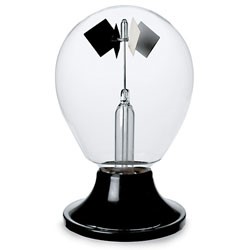Study Guide: Radiometer
Vocabulary
- Light Energy
- Light Ray
- Solar energy
- Thermal energy
- Kinetic energy
- Absorption
- Molecule
- Atmosphere
- Radiation
Materials
- Radiometer
- Sunlight
- Objects to create shadows
Procedures
- We placed the Radiometer in darkness and observed that it did not spin.
- Then we placed the Radiometer in full sunlight and observed that it rotated rapidly.
- While the Radiometer is in full sunlight, we created shadows to block light rays from reaching the Radiometer, and observe that it stopped spinning.
- Then we removed the shadows letting the sunlight hit the Radiometer again, and observed it spin rapidly.
Explanation
Heat energy moves from hot objects to cold objects by conduction, convection and radiation. Of these three, only radiation does not require actual contact. For example, the sun warms the Earth because its heat radiation travels through empty space. Any warm object, such as the sun, a toaster or the human body, gives off thermal energy, called infrared radiation, or I.R.
When sunlight hits the white sides of the Radiometer panes, it is reflected away from the lighter surfaces. This is why they white to us. When sunlight hits the black sides of the panes, the light energy is absorbed and converted into heat. This is why they looks black to us.
When air molecules in the Radiometer bump into the black panes, they absorb some of the thermal energy (heat). This extra energy causes the molecules to bounce away from the black panes faster than from the white panes. This in turn causes the Radiometer to spin away from the black panes.
Energy is never lost or gained. It is only converted into different forms. In this case, solar energy (light) is transferred into thermal energy (heat) and then into mechanical energy (movement). The brighter the light, the more heat energy is transferred, and the faster the vanes rotate.
History
Sir William Crookes developed the radiometer in 1873 while studying infrared radiation. He thought that the reason the radiometer vanes turned was because of pressure from light particles on the shiny surfaces. Many other theories were developed to explain the movement, but the explanation that most scientists today think is correct was provided by Osborne Reynolds in 1987. He proposed that temperature differences on the two sides of the vanes stimulated gasses to move from the cold side to the warm side of each pane. Because the molecules bounce off the warmer side faster where they have absorbed more thermal energy (heat), they push the vanes toward the cooler side. This then causes the cooler gas on the lighter (more refective) side to move around the pane toward the warmer side, where in turn is warmed and bounces away.
Make Your Own Radiometer
- Using a permanent marking pen, color the paper side of a silver gum wrapper black. Let it dry, then cut it into four equally-sized piecespieces. Smooth out the four pieces as flat and wrinkle-free as you can.
- Put a dot of super glue on one side of the match and spread it with a tooth pick. Attach the edge of one piece of gum wrapper to that side, so that it sticks out like a flag. Attach the remaining pieces of gum wrapper to the remaining sides of the match, with the shiny sides all facing in the same direction.
- Tie a thread to the bottom end of the match. Tie the other end of the thread to a pencil, about 2 inches from the match.
- Balance the pencil on the jar, with the match and its four flags hanging down inside the jar, but not touching the bottom. The straighter the match and the flags, the better the balance. Place the jar in a very sunny location or near a hot light source.



